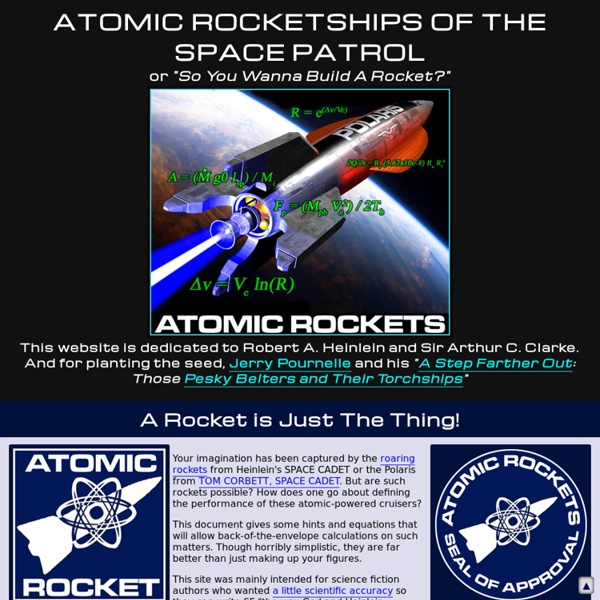Atomic Rockets main page
Your imagination has been captured by the roaring rockets from Heinlein's SPACE CADET or the Polaris from TOM CORBETT, SPACE CADET. But are such rockets possible? How does one go about defining the performance of these atomic-powered cruisers? This document gives some hints and equations that will allow back-of-the-envelope calculations on such matters. Though horribly simplistic, they are far better than just making up your figures. This site was mainly intended for science fiction authors who wanted a little scientific accuracy so they can write SF "the way God and Heinlein intended" (Arlan Andrews's Law). The engine and the torchship pages explain how easily do some of the calculations using Nomograms. . While this site originally focused on rocketry equations, as you can see it has grown to encompass other topics of interest to SF authors and game designers.
Giant In the Playground Games
Bad Astronomy - Slate
A new paper just published in the prestigious Astrophysical Journal makes a stunning claim: There are 10 times as many galaxies in the Universe as we previously thought. At least. The total number comes in at about 2 trillion of them. Now, let me be clear. This doesn’t meant the Universe is 10 times bigger than we thought, or there are 10 times as many stars. What the astronomers did was look at extremely deep images of the Universe taken in surveys, for example the Hubble Ultra Deep Field. That’s a lot of galaxies. Surveys like the UDF are limited. The astronomers who did this research had an interesting problem. The answer is two-fold. Those numbers change with distance. At the same time, these faint galaxies are easier to see close to us, and harder farther away. They calculated this for all kinds of galaxies, right down to really small ones with about a million times the mass of the Sun. And that’s how they found that there are at least 2 trillion galaxies in the Universe.
3-D Starmaps:Actual Maps
In some cases distance data was tweaked when different catalogs assigned inconsistent distances to objects that are actually associated. "Beacon” stars are bright stars with absolute magnitudes of zero or less. “Pre-supernova” stars are commonly believed by astronomers to be on the verge of exploding Real Soon Now (i.e., anytime from one million years from now to tomorrow). “Collider” is Gliese 710. There is a fair chance it will collide with our solar system in approximately 1.4 million years, or at least pass by close enough to initiate a deadly hail of comets. The “local bubble” is an area of reduced density in the interstellar medium, which is bad news for Bussard Ramjet spacecraft. Only the Sunward half of the galaxy was plotted due to a lack of data for objects on the far side. Blue lines measure angles and distances from the galactic core. Distances are in light-years instead of parsecs, which will please science fiction writers and annoy astronomers.
The Adventures of Dr. McNinja
Geeks are Sexy Technology News | tech, science, news and social issues for geeks
The Virginia Woolf Society of Great Britain
The Spoony Experiment - Because bad movies and games deserve to be hurt back!
Climate Depot | A project of CFACT
Related:
Related:



